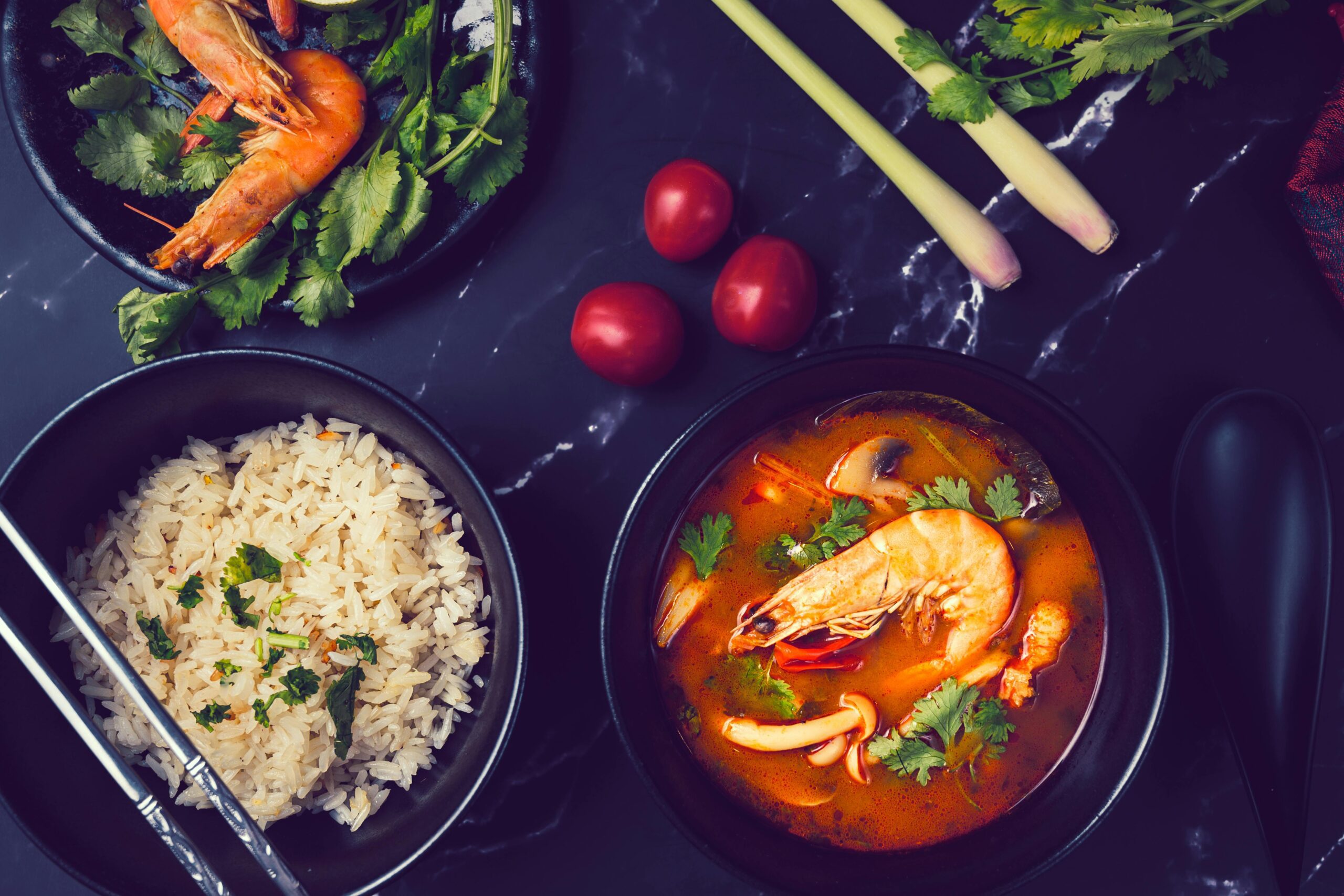The Origins of Seafood Soup
In regions like the Mediterranean, where seafood has been a staple for centuries, seafood-based broths were not only nutritious but also served as a way to preserve the catch of the day, thus providing a practical solution for storing fresh seafood.. Over time, the idea of a seafood soup spread, evolving to reflect the local ingredients, traditions, and culinary techniques of different cultures.
For instance, the Mediterranean boasts the famous Bouillabaisse, a rich and fragrant fish stew from Provence, France. Similarly, Cioppino hails from the Italian-American communities of San Francisco, combining fish, shellfish, tomatoes, and wine into a delightful, savory soup. In Asia, seafood soups like Tom Yum from Thailand and Korean Maeuntang incorporate bold, spicy, and tangy flavors that reflect the region’s love for vibrant, aromatic dishes.
Key Ingredients in Seafood Soup
-
Seafood – The star of the dish, the seafood used in the soup can be tailored to suit personal tastes or what’s in season. Common choices include firm white fish, like cod or halibut, shellfish like shrimp and scallops, and bivalves like clams and mussels.
-
Broth – The base of the soup is often made from a combination of fish stock, vegetable stock, or even a tomato-based broth, depending on the type of soup. They can enrich broths with white wine, herbs, and seasonings like garlic, onions, and bay leaves.
-
Vegetables – Onions, celery, carrots, and leeks are common vegetables used to create the flavor foundation of the soup. These vegetables are often sautéed at the start to release their natural sweetness.
-
Herbs and Spices – Fresh herbs such as thyme, parsley, basil, and fennel can be added to seafood soups to enhance the aroma and taste. They may include spices like saffron, paprika, and chili peppers for depth and heat, as in the case of a spicier seafood soup from Southeast Asia.
-
Acidity and Umami – Many seafood soups benefit from a touch of acid, whether from lemon juice, tomatoes, or white wine. The acidity helps to balance the richness of the seafood and the broth. Adding ingredients like anchovies or a dash of soy sauce can also bring out the umami flavors, creating a more complex and savory soup.
Popular Seafood Soup Varieties
-
Bouillabaisse (France) – Originating from the coastal city of Marseille, Bouillabaisse is a rich fish soup traditionally made with a variety of local fish and shellfish, along with tomatoes, saffron, garlic, and olive oil. The dish is often served with a side of rouille, a garlicky mayonnaise-like sauce that adds a creamy texture.
-
Cioppino (USA) – This Italian-American seafood stew was created by fishermen in San Francisco, using the freshest local seafood and simmering it in a tomato-based broth with wine, garlic, and herbs. It’s hearty, comforting, and brimming with seafood, often served with crusty bread to soak up the flavorful broth.
-
Tom Yum (Thailand) – Known for its vibrant, tangy, and spicy profile, Tom Yum is a Thai soup made with shrimp or fish, mushrooms, and fresh herbs like lemongrass, kaffir lime leaves, and galangal. They often infuse this soup with lime juice and fish sauce to balance sour, salty, and spicy flavors.
-
Korean Maentang – Maentang is a spicy and savory Korean seafood soup, typically made with fish and sometimes octopus or other shellfish. They season the broth with gochujang (Korean chili paste), gochugaru (chili flakes), garlic, and fermented soybean paste, creating a flavorful, spicy base.
New England Clam Chowder (USA) – This famous American soup is creamy and comforting, made with clams, potatoes, onions, and celery, all enveloped in a velvety broth of cream and butter .They usually serve it in a bread bowl, making it a more delicious and filling meal.
Creating a great seafood soup at home is easier than you might think. Here are a few tips to help you achieve a flavorful and satisfying dish:
-
Use Fresh Seafood: Fresh seafood makes all the difference in flavor. If fresh seafood is not available, high-quality frozen seafood is a great alternative.
-
Don’t Overcook the Seafood: Seafood cooks quickly, so be mindful of cooking times. Overcooked seafood can become rubbery and lose its delicate flavor.
-
Layer the Flavors: Start by building your flavor base with onions, garlic, and herbs. Don’t rush the sautéing process—this will help to create a deep, savory broth.
-
Balance the Broth: Taste the broth as it simmers. Adjust the seasoning with salt, pepper, lemon juice, or a splash of white wine. Remember, the broth should complement the seafood without overpowering it.
Seafood soup is a flavorful dish that connects us to the sea, offering comfort and nourishment. Whether light or creamy, there’s a seafood soup for every taste—perfect for a warm, savory meal.
-
Firstly – To introduce the main idea or initial point.
-
Firstly, seafood soup combines various fresh ingredients for a rich and savory broth.
-
-
In addition – To add another related point.
-
In addition to the fish, shellfish is often added for extra flavor.
-
-
Moreover – To provide more details or emphasize.
-
Moreover, the soup is often seasoned with garlic, herbs, and spices.
-
-
For example – To give an example.
-
For example, a classic Mediterranean seafood soup features tomatoes, herbs, and a mix of shellfish.
-
-
As a result – To show the consequence or effect.
-
As a result, the soup becomes a nutritious and flavorful dish.
-
-
Meanwhile – To show something happening at the same time.
-
Meanwhile, they simmer the seafood to perfection, releasing its flavors into the broth.
-
-
However – To introduce a contrast.
-
However, some variations use a creamy base instead of a clear broth.
-
-
In conclusion – To wrap up or summarize.
-
“In conclusion, people can adapt seafood soup to different tastes and preferences, making it a versatile dish.”
-
-
Additionally – To add information.
-
Additionally, a squeeze of lime juice can enhance the flavor.
-
-
Therefore – To show a cause-and-effect relationship.
-
Therefore, seafood soup is not only delicious but also highly nutritious.
-
To begin with – To introduce the first point.
-
To begin with, the base of a seafood soup is often a well-seasoned broth.
-
-
Following this – To indicate a sequence of events.
-
They add the seafood to the simmering broth following this, allowing it to infuse the flavors.
-
-
As mentioned earlier – To refer to a previously mentioned point.
-
As we mentioned earlier, they can make the broth with ingredients like white wine and garlic for extra depth.
-
In contrast – To highlight a difference.
-
-
-
In contrast to the light broths, some chefs make seafood soups with a creamy base.
-
-
On the other hand – To introduce an opposing point.
-
On the other hand, some recipes include coconut milk for a richer texture.
-
-
For instance – To give an example or provide clarification.
-
For instance, Thai seafood soup often features lemongrass and chili for a bold flavor.
-
-
Equally important – To introduce a point of equal significance.
-
Equally important is the use of fresh, local ingredients to elevate the soup’s flavor.
-
-
In particular – To emphasize a specific detail.
-
In particular, adding saffron can give the soup a distinct aroma and color.
-
-
As a matter of fact – To emphasize the truth of a statement.
-
As a matter of fact, people know seafood soup for its health benefits, including high levels of omega-3 fatty acids.
-
-
To sum up – To give a summary or conclusion.
-
To sum up, many cultures enjoy seafood soup for its flavor, nutrition, and adaptability, making it a versatile dish.
-
-
Not only… but also – To show two related points.
-
Not only does seafood soup provide a hearty meal, but it also offers a burst of oceanic flavors.
-
-
Because of this – To explain a reason or cause.
-
Because of this, people often serve seafood soups as a comforting dish during colder months.
-
-
In other words – To rephrase or clarify.
-
In other words, seafood soup is a perfect blend of fresh ingredients that create a wholesome and tasty meal.
-
-
Subsequently – To indicate something that follows in time or order.
-
Subsequently, they let the soup simmer until all the flavors have fully developed.
-
-
To illustrate – To provide a clearer example.
-
To illustrate, cooks thicken some seafood soups like chowder with cream or flour to add richness.
-
-
Similarly – To compare in a similar manner.
-
Similarly, Mediterranean seafood soups often incorporate olives and tomatoes for extra flavor.
-
-
Ultimately – To show the final point or conclusion.
-
Ultimately, seafood soup brings together the freshness of the ocean and the warmth of a well-seasoned broth.
-











